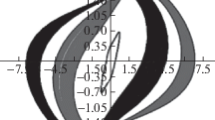Abstract
In this paper, we propose new approaches to the construction of extremely multistable systems containing one-, two-, and three-dimensional lattices of identical hidden chaotic attractors possessing the same Lyapunov exponents. In particular, we prove that for multidimensional models of automatic control systems in the Lurie form, it is always possible to pass from an interactive system to a cascade system; this substantially simplifies the procedure for constructing multidimensional lattices of identical chaotic attractors.
Similar content being viewed by others
References
F. T. Arecchi, R. Meucci, G. Puccioni, and J. Tredicce, “Experimental evidence of subharmonic bifurcations, multistability, and turbulence in a Q-switched gas laser,” Phys. Rev. Lett., 49, No. 17, 12–17 (1982).
B. Bao, Q. Li, N. Wang, and Q. Xu, “Multistability in Chua’s circuit with two stable node-foci,” Chaos, 26(4), 043111 (2016).
I. M. Burkin, “Hidden attractors of some multistable systems with infinite number of equilibrium states,” Chebyshev. Sb., 18, No. 4, 127–138 (2017).
I. M. Burkin and N. K Nguen, “Analytical-numerical methods of finding hidden oscillations in multidimensional dynamical systems,” Differ. Equations, No. 50, 1695–1717 (2014).
V. O. Bragin, V. I. Vagaitsev, N. V. Kuznetsov, and G. A. Leonov, “Algorithms for finding hidden oscillations in nonlinear systems. The Aizerman and Kalman conjectures and Chua’s circuits,” J. Comput. Syst. Sci. Int., 50, No. 4, 511–543 (2011).
S. Cicek, A. Ferikoglu, and I. Pehlivan, “A new 3D chaotic system: dynamical analysis, electronic circuit design, active control synchronization and chaotic masking communication application,” Optik, No. 127, 4024–4030 (2016).
D. Dudkowskia, S. Jafari, T. Kapitaniak, N. V. Kuznetsov, and G. A. Leonov, “Hidden attractors in dynamical systems,” Phys. Rep., No. 637, 1–50 (2016).
A. Komarov, H. Leblond, and F. Sanchez, “Multistability and hysteresis phenomena in passively mode-locked fiber lasers,” Phys. Rev., 71 (5), 053809 (2005).
N. V. Kuznetsov, “Hidden attractors in fundamental problems and engineering models. A short survey,” Lect. Notes Electr. Eng., No. 371, 13–25 (2016).
Q. Lai and S. Chen, “Research on a new 3-D autonomous chaotic system with coexisting attractors,” Optik, No. 127, 3000–3004 (2016).
Q. Lai and S. Chen, “Generating multiple chaotic attractors from Sprott B system,” Int. J. Bifurc. Chaos, 26, 21650177 (2016).
M. Laurent and N. Kellershohn, “Multistability: a major means of differentiation and evolution in biological systems,” Trends Biochem. Sci., 24 (11), 418–422 (1999).
G. A. Leonov, Control Theory, St. Petersburg (2006).
G. A. Leonov, I. M. Burkin, and A. I. Shepeljavyi, Frequency Methods in Oscillation Theory, Kluwer, Amsterdam (1996).
G. A. Leonov, N. V. Kuznetsov, and V. I. Vagaitsev, “Localization of hidden Chua’s attractors,” Phys. Lett., No. 375, 2230–2233 (2011).
C. Li, W. Hu, J. C. Sprott, and X. Wang, “Multistability in symmetric chaotic systems,” Eur. Phys. J. Spec. Top., No. 224, 1493–1506 (2015).
C. Li and J. C. Sprott, “Multistability in the Lorenz system: a broken buttery,” Int. J. Bifurc. Chaos., 24 (10), 1450131 (2014).
C. Li, J. C. Sprott,W. Hu, and Y. Xu, “Infinite multistability in a self-reproducing chaotic system,” Int. J. Bifurc. Chaos., 27 (10), 1750160 (2017).
C. Li, J. C. Sprott, T. Kapitaniak, and T. Lu, “Infinite lattice of hyperchaotic strange attractors,” Chaos Solitons Fract., No. 109, 76–82 (2018).
C. Li, J. C. Sprott, and Y. Mei, “An invite 2-D lattice of strange attractors,” Nonlin. Dynam., 89, No. 4, 2629–2639 (2017).
Z. Li and D. Xu, “A secure communication scheme using projective chaos synchronization,” Chaos Solitons Fract., No. 22, 477–481 (2004).
H. Liu, A. Kadi, and Y. Li, “Audio encryption scheme by confusion and diffusion based on multiscroll chaotic system and one-time keys,” Optik, No. 127, 7431–7438 (2016).
S. R. Ujjwal, N. Punetha, R. Ramaswamy, M. Agrawal, and A. Prasad, “Driving-induced multistability in coupled chaotic oscillators: symmetries and riddled basins,” Chaos, 26, 063111 (2016).
G. Wang, D. Chen, J. Lin, and X. Chen, “The application of chaotic oscillators to weak signal detection,” IEEE Trans. Ind. Electron., No. 46, 440–444 (1999).
Q. Xu, Y. Lin, B. Bao, and M. Chen, “Multiple attractors in a non-ideal active voltage-controlled memristor based Chua’s circuit,” Chaos Solitons Fract., No. 83, 186–200 (2016).
L. Ying, D. Huang, and Y. C. Lai, “Multistability, chaos, and random signal generation in semiconductor superlattices,” Phys. Rev. E, 93 (6), 062204 (2016).
Z. Zeng, T. Huang, and W. Zheng, “Multistability of recurrent neural networks with time-varying delays and the piecewise linear activation function,” IEEE Trans. Neural Networks, No. 21 (8), 1371–1377 (2010).
Author information
Authors and Affiliations
Corresponding author
Additional information
Translated from Itogi Nauki i Tekhniki, Seriya Sovremennaya Matematika i Ee Prilozheniya. Tematicheskie Obzory, Vol. 168, Proceedings of the International Conference “Geometric Methods in the Control Theory and Mathematical Physics” Dedicated to the 70th Anniversary of Prof. S. L. Atanasyan, 70th Anniversary of Prof. I. S. Krasil’shchik, 70th Anniversary of Prof. A. V. Samokhin, and 80th Anniversary of Prof. V. T. Fomenko. Ryazan State University named for S. Yesenin, Ryazan, September 25–28, 2018. Part I, 2019.
Rights and permissions
About this article
Cite this article
Burkin, I.M., Kuznetsova, O.I. An Approach to Generating Extremely Multistable Chaotic Systems. J Math Sci 262, 779–789 (2022). https://doi.org/10.1007/s10958-022-05856-2
Published:
Issue Date:
DOI: https://doi.org/10.1007/s10958-022-05856-2
Keywords and phrases
- dynamical system
- chaos
- extreme multistability
- displacement of phase flow
- Lyapunov exponent
- Kaplan–Yorke dimension



